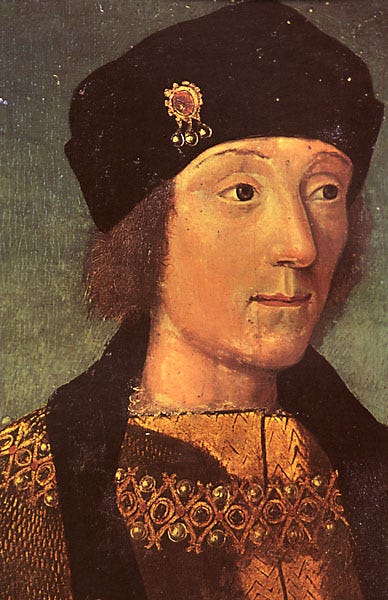The Christmas Day Oath
On 25 December 1483, Henry Tudor swore to marry Elizabeth of York. And so it began.
Merry Christmas, everyone! Nadolig Llawen, pawb!
Hope you’ve had a peaceful day full of food and books! Comment below what you received!
The dawn of the Tudor age is often regarded as the summer of 1485 when Henry Tudor defeated Richard III at the Battle of Bosworth to become Henry VII. But Christmas Day 1483 holds huge significant in the Tudor family story. It was a day that perhaps changed the fate of England, and perhaps the western world, forever.
It was on 25 December that year that Henry Tudor faced his assembled supporters from near the altar in Rennes’ St Peter’s Cathedral, and tentatively spoke. Before him were around four hundred rebels, men who had gradually come together united by a common cause – the downfall of Richard III. Some were diehard Lancastrians like Jasper Tudor or John de Vere, Earl of Oxford, and others were disaffected Yorkists who took a dim view of Richard’s deposing of his nephew, Edward V.
Also present was a Breton delegation, including the duchess of Brittany, Marguerite of Foix, and the duchy’s leading minister, Pierre Landais. When Henry, the man this disparate collection of English rebels now looked to as their leader, started speaking, everyone listened. He knew that he was about to be scrutinised closely.
His voice reverberating around the cold nave as men warmed themselves by rubbing their hands together and gently swaying back and forth, Henry voiced his gratitude for their support to this point, and solemnly pledged to do all he could to depose the tyrant in England from his ill-gotten throne.
As their rightful monarch, Henry claimed he would return England to prosperity and peace, eradicating the scourge of war from the land once and for all. All would soon be back on their abandoned estates, returned to their former positions of influence and able to celebrate with their much-missed families. Their present predicament would soon be a legendary tale shared with laughter among friends, an adventure they conquered together.
To bind together their cause, Henry swore that he would take for his wife Elizabeth of York, the daughter of Edward IV and eldest sister of the Princes in the Tower, who many now presumed had been silenced forever. This vow would also help shore up any dynastic deficiencies in Henry’s own, shaky, claim to the throne. It is likely that just a month previously, the figurehead for the anti-Richard campaign had been the duke of Buckingham, descended thrice over from Edward III.
Now that Buckingham’s head was upon a spike in Salisbury marketplace, the focus of the rebellion shifted to Henry Tudor. He was also descended from Edward III, but through a female line that had once been illegitimate. To publicly acknowledge Elizabeth as the rightful heir of the House of York, the Yorkist contingent must have had good reason to believe her brothers were dead by this point.
With little other option, the rebels in Rennes swore homage to the figure stood before them, a 26-year-old later described as taller than average, with a body that though slender was well-built and strong. His face was apparently attractive and cheerful, especially when speaking, which held him in good stead at this very moment. The rebels now accepted Henry Tudor as though he had already been created king and placed their lives at his disposal.
A plot to create a new path for England, therefore, part-Lancastrian, part-Yorkist, all-Tudor, owes its origins to this remarkable Christmas Day oath by Henry. In swearing to take Elizabeth of York as his wife, so it all began…





We’re in ffostrasol
A beautiful coronation bracelet and a Tudor Rose necklace! Bought from the Westminster Abbey online gift shop!